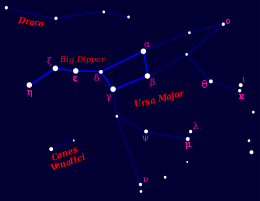
An asterism is an observed pattern or group of stars in the sky. Asterisms can be any identified pattern or group of stars, and therefore are a more general concept then the formally defined 88 constellations. Constellations are based on asterisms, but unlike asterisms, constellations outline and today completely divide the sky and all its celestial objects into regions around their central asterisms. For example, the asterism known as the Big Dipper comprises the seven brightest stars in the constellation Ursa Major. Another is the asterism of the Southern Cross, within the constellation of Crux.
Asterisms range from simple shapes of just a few stars to more complex collections of many stars covering large portions of the sky. The stars themselves may be bright naked-eye objects or fainter, even telescopic, but they are generally all of a similar brightness to each other. The larger brighter asterisms are useful for people who are familiarizing themselves with the night sky.
The patterns of stars seen in asterisms are not necessarily a product of any physical association between the stars, but are rather the result of the particular perspectives of their observations. For example the Summer Triangle is a purely observational physically unrelated group of stars, but the stars of Orion’s Belt are all members of the Orion OB1 association and five of the seven stars of the Big Dipper are members of the Ursa Major Moving Group. Physical associations, such as the Hyades or Pleiades, can be asterisms in their own right and part of other asterism at the same time.
Credit : Wikipedia
Picture Credit : Google




